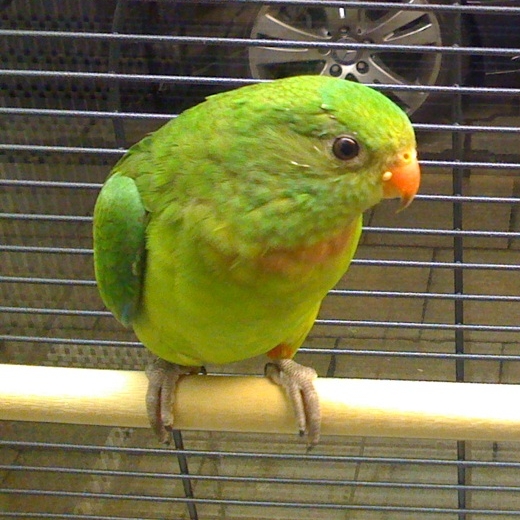 Gorgeous, friendly and a talented mimic, this Australian native truly lives up to its name. The Superb Parrot (Polytelis swainsoni), although not as commonly kept as many related species, is very hardy and an excellent choice for those wishing to expand their parrot-keeping horizons.
Gorgeous, friendly and a talented mimic, this Australian native truly lives up to its name. The Superb Parrot (Polytelis swainsoni), although not as commonly kept as many related species, is very hardy and an excellent choice for those wishing to expand their parrot-keeping horizons.
Description and Natural History
The Superb Parrot has a slim, elongated body of 12-14 inches in length. The torso is clad in brilliant green and the flight feathers are blue. The male’s forehead, throat and cheeks are bright yellow, and the throat is decorated with a splash of crimson red.
It has an extremely limited natural range, being found only along several rivers in Southeastern Australia (mainly Southern New South Wales and Victoria). There it frequents lightly wooded areas, overgrown scrub and the borders of farms and ranches, going about in small flocks and feeding upon Eucalyptus blossoms and nectar, seeds, fruit, and insect larvae. Superb Parrots often forage on the ground and are quick to take advantage of spilled grain, flowering ornamental trees and other novel feeding opportunities.
Superb Parrots as Pets
Fortunately for the species and its human fans, the Superb Parrot is well-established in captivity and actually rather easy to breed. They are inquisitive and quick to bond with people, and become quite trusting in short order. Mimicry comes easily to the Superb Parrot, and many develop quite impressive vocabularies.
Breeding
Breeding occurs most often in large outdoor aviaries. Wild Superb Parrots usually nest in small groups, with 3-4 pairs utilizing different cavities in the same or nearby trees, but captives rarely breed in a colony situation. Therefore, prospective breeders should be given a large enclosure to themselves.
They do, however, get along well with many birds, including other parrots, quails and doves. In fact, Superb Parrots enthusiastically interbreed with a surprising array of other Psittacines, including King and Red-Winged Parrots, Eastern Rosellas and Princess of Wales Parakeets.
A typical clutch contains 4-5 eggs, which are incubated by the female (she may be fed on the nest by her mate). The chicks hatch in approximately 22 days and fledge by day 40. Pairs may breed for extended periods of time – more than 2 decades according to some aviculturists.
Diet
Superb Parrots do well on a seed and pellet-based diet (Nutriberries) are an excellent means of introducing pellets to picky eaters), but require a good deal of variety if they are to remain in peak condition and color. Fruits, vegetables, fruit tree buds and flowers such as dandelion should be offered on a regular basis. They reportedly take insect larvae in the wild, so waxworms and mealworms are worth trying.
Like most parrots, these active birds take great pleasure in stripping leaves, bark and buds from freshly-cut fruit tree branches.
Further Reading
This Birds in Backyards article provides detailed natural history and conservation-oriented information.
This video of a courting pair of Superb Parrots leaves not doubt as to the suitability of their name!
Superb Parrot image referenced from wikipedia and originally posted by Paulgear
Superb Parrot in pet shop image referenced from wikipedia and originally posted by Snowmanradio and Sergio Almeida
 That Bird Blog – Bird Care and History for Pet Birds
That Bird Blog – Bird Care and History for Pet Birds




